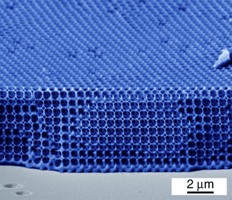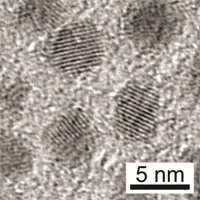The Goals of OMEL

Nanotechnology now provides the ability to shape and pattern matter in amazing ways. The goal of the Optical Materials Engineering Laboratory (OMEL) is to utilize this ability to create materials that have interesting and advantageous interactions with light. By tailoring the size, shape, or periodicity of a solid, one can alter its optical behavior. Moreover, if one is clever, one can create properties not observed in any natural material.
In OMEL, we aim to fabricate such structures and investigate the new phenomena that result. While we sometimes employ the sophisticated processes developed by the semiconductor industry to shape our materials, we also seek much simpler strategies, e.g., based on colloidal chemistry or self-assembly. This is demonstrated in the figure above, which shows a thin film of silicon that has been periodically patterned using self-assembly. This structure, known as a photonic crystal, exhibits strong interactions with light due to the periodicity embedded in the film.
Within our broad goals stated above, current efforts within OMEL are focused on two specific classes of optical materials: (i) nanoscale semiconductor particles (known as nanocrystals, see electron micrograph below) to investigate the influence of size and (ii) thin patterned metals (known as plasmonic films) to investigate shape. In addition to studying fundamental properties of these materials, we are exploring their use to improve optical devices, from solar cells to new types of lasers. Because we fabricate and characterize all of our own structures and devices, researchers within OMEL become highly proficient in a broad range of skills. We also actively seek interactions with industry to develop our results beyond the laboratory.
More project details can be found on the research link on this webpage.
